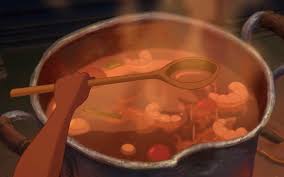By Elizabeth Quartey
In the world of fairy tales, symbolism often molds the meaning of the tale. In the Brothers Grimm’s The Frog Prince, the frog represents transformation, abundance, and connection to the earth’s riches. Disney’s The Princess and the Frog cleverly adjusts this symbolism, using gumbo in its stead, an African American dish. By examining the parallels between the frog in the original tale and gumbo in the Disney adaptation, we can see how African American food serves as both a cultural anchor and a metaphor for transformation and success.

Frogs symbolize the earth and its fruitfulness. In many cultures, frogs represent abundance, wisdom, and the changing of seasons. Their presence in fairy tales usually represents prosperity, reminding the readers of the fundamental harmony of nature. In The Frog Prince, the frog becoming a prince highlights the value of looking beyond appearances to find hidden value. Similarly, in The Princess and the Frog, gumbo represents a blending of simple ingredients into something comforting, symbolizing the prosperity that comes from being in a community.

Gumbo’s history mirrors this theme of transformation. As Michael Twitty explains in The Cooking Gene, gumbo originated in West Africa, where enslaved Africans introduced okra to the Americas. Over many generations, gumbo turned into a dish that reflects the diversity of New Orleans, using African, Indigenous, and Spanish influences. Serious Eats highlights how different types of gumbo like seafood, chicken, and sausage, thickened with okra, roux, or filé powder speak to its adaptability. Each version implies resourcefulness and resilience, much like the frog’s journey from amphibian to prince.


In The Princess and the Frog, gumbo is essential to Tiana’s aspirations. Gumbo represents her connection to her family, as well as her dreams of owning a restaurant. The scene where young Tiana cooks gumbo with her father perfectly encapsulates this symbolism. Her act of cooking becomes a way of envisioning a hopeful future.

The parallels between gumbo and the frog deepen when viewed through the lens of the original story The Frog Prince. Just as the frog’s transformation requires the princess to embrace what she initially rejects, gumbo’s beauty lies in its ability to turn simple, overlooked ingredients into something extraordinary. The moral of both stories is clear: true value often lies in the unassuming and the overlooked. By embracing these elements, both the princess and Tiana achieve success.The choice to center gumbo in The Princess and the Frog carries significant cultural weight. Historically, African American cuisine has been made into caricatured, but the Disney film treats gumbo with respect. Parasecoli notes that this portrayal was almost unheard of, offering a positive narrative that celebrates Black foods as creative and even appetizing. Gumbo becomes a metaphor, much like the frog in the original tale.


Works Cited:
Huggins, Alissa. “The Spiritual Meaning of Frogs.” Well+Good, 15 Mar. 2023, www.wellandgood.com/spiritual-meaning-frogs/#:~:text=Many%E2%80%94but%20not%20all%E2%80%94cultures,a%20good%20omen%2C%20signaling%20prosperity.
Grimm, Jacob, and Wilhelm Grimm. The Frog King, or Iron Henry. Translated by Edgar Taylor, Project Gutenberg, 2008, www.gutenberg.org/ebooks/14562.
Parasecoli, Fabio. “A Taste of Louisiana: Mainstreaming Blackness Through Food in The Princess and the Frog.” Journal of African American Studies, vol. 14, no. 4, Dec. 2010, pp. 450-468. https://doi.org/10.1007/s12111-010-9137-y.
Citation: Twitty, Michael W. The Cooking Gene: A Journey Through African American Culinary History in the Old South. HarperCollins, 2017.
Serious Eats. “The History of New Orleans Gumbo: Okra, File Powder, and Beyond.” Serious Eats, 18 Dec. 2020, www.seriouseats.com/history-new-orleans-gumbo-okra-file-powder. Accessed 22 Nov. 2024
The Princess and the Frog. Directed by Ron Clements and John Musker, Walt Disney Pictures, 2009.